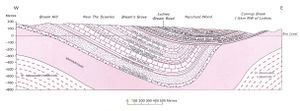The Malvern Axis and Pre- and Intra-Carboniferous earth movements, Bristol and Gloucester region
| Green, G W. 1992. British regional geology: Bristol and Gloucester region (Third edition). (London: HMSO for the British Geological Survey.) |


The Malvern Axis
The Malvern ‘Line’ or ‘Axis’ has long been regarded as one of the fundamental elements in the structure of the region, extending into it from the Welsh Borderland to the north. The ‘Axis’ is named after the narrow, elongate, north-south-trending horst of Precambrian igneous and metamorphic rocks that forms the Malvern Hills and which has been the site of uplift, including reverse faulting, at intervals since Precambrian times. The eastern boundary fault of the horst forms the western limit of the Mesozoic Worcester Basin in that area. At the southern end of the Malverns, the Precambrian rocks plunge out of sight beneath younger rocks, but are inferred from geophysical, mainly magnetic data, to extend south-south-eastwards beneath the Worcester Basin to near Tetbury, where they are estimated to lie at a depth of 3 km below the surface (Cave 1977, p.246)[1].
The anticlinal axis at Huntley, to the east of Mitcheldean, the core of which is occupied by Silurian (Llandovery) rocks, and the en échelon Berkeley Fault and Coalpit Heath Syncline to the south, all trend in a north-north-westerly to north-north-easterly direction. They have either severally or together been referred to in the literature as manifestations of the Malvern ‘Line’ or ‘Axis’, but the name Malvern Fault Belt, recently coined by Kellaway and Hancock (1983)[2], is more appropriate.
Pre-Carboniferous movements
Knowledge of early earth movements within the district is poor. Silurian rocks (Upper Llandovery) unconformably overlie the Cambrian (Tremadoc) in the Tortworth area; and, rather better known, is the interruption to sedimentation represented by the pre-Upper Devonian (Farlovian) unconformity. As a result of it, the thick Middle Devonian sequences of the areas to the south are absent from most of the region, while gentle folding accompanied by faulting and erosion has resulted in local, but appreciable overstep by the Upper Old Red Sandstone onto older formations. Movement was strongest in the Tortworth area, where the pre-Farlovian strata have undergone horst-type uplift aligned in a north-south direction that has resulted, following much subsequent erosion, in the Upper Old Red Sandstone directly overlying Wenlock strata in the central part of the uplift. Due to the cover of later rocks, only the western side of the structure, comprising the Berkeley Fault, is clearly seen; this has a pre-Farlovian downthrow to the west of some 600 m (Cave, 1977, fig. 22)[1]. Apart from this uplift, the early Palaeozoic rocks of the Tortworth inlier are generally more faulted and folded than the adjacent Carboniferous rocks, probably due to Caledonian movements, but the overwhelming effect of the later Variscan movements makes it hard to be sure. South of the Tortworth area, the Upper Old Red Sandstone in the eastern Mendips rests directly on Silurian (Wenlock) strata with low angular unconformity, and it has been suggested that the two areas lie on a north-south axis of uplift related to the Malvern Fault Belt.
Intra-Carboniferous movements
During much of the Carboniferous period, the two sinking areas of thick continuous sedimentation represented by the South Wales Coalfield in the west and the Bristol and Somerset coalfields in the east were separated by an area in which the Carboniferous successions may show attenuation and nonsequence, and include important unconformities at the base of the Namurian, within the Westphalian and possibly also within the late Visean. Uplift and concomitant erosion appear to have been most active at the margins of the area, adjacent to the main coalfields, namely along the Malvern and Lower Severn ‘axes’ on the east and the Usk and Vale of Glamorgan ‘axes’ in the west (P948966). It has recently been suggested that these earth movements are related to an important dextral strike-slip fault, postulated to lie beneath the Severn estuary, analogous to the well-known Vale of Neath and Swansea Valley ‘disturbances’ farther west (Wilson et al., 1988)[3].
The combined effect within the district of these movements is illustrated in P948966, which shows a diagrammatic reconstruction of the outcrops on which it is thought the higher Westphalian strata (probably Westphalian C = Bolsovian) were deposited. Folding, and hence angular unconformity, is confined to the belt of maximum uplift, and it is most strikingly shown in the Forest of Dean (P948969). It is probable that the late Westphalian measures formerly overstepped onto Lower Palaeozoic strata a short distance to the east of the present coalfield (P948969). The evidence for an early Westphalian age for part of the Drybrook Sandstone indicates that the main intra-Carboniferous folding along the line of the Lower Severn–Malvern ‘Axis’ was mid-Westphalian in age. This episode of folding is regarded as the first pulse of the main Variscan orogenic movements. There is evidence to suggest that Coal Measures may attenuate eastwards along the eastern side of the Bristol Coalfield, and it has been suggested that a southwards continuation of the Malvern Fault Belt adjacent to the eastern margin of the coalfield may have been a positive area analogous to the Lower Severn ‘Axis’ (Kellaway and Welch, 1948[4]; Kellaway and Hancock, 1983[2]).
References
- ↑ 1.0 1.1 Cave, R. 1977. Geology of the Malmesbury district. Memoir of the Geological Survey of Great Britain.
- ↑ 2.0 2.1 Kellaway, G A, and Hancock, P L. 1983. Structure of the Bristol district, the Forest of Dean, and the Malvern Fault Zone. 88-107 in The Variscan Fold Belt in the British Isles. Hancock, P L (editor). (Bristol: Adam Hilger.)
- ↑ Wilson, D, Davies, J R, and Waters, R A. 1988. Structural controls on Upper Palaeozoic sedimentation in south-east Wales. Journal of the Geological Society of London, Vol. 145, 901–914.
- ↑ Kellaway, G A, and Hancock, P L. 1983. Structure of the Bristol district, the Forest of Dean, and the Malvern Fault Zone. 88-107 in The Variscan Fold Belt in the British Isles. Hancock, P L (editor). (Bristol: Adam Hilger.)